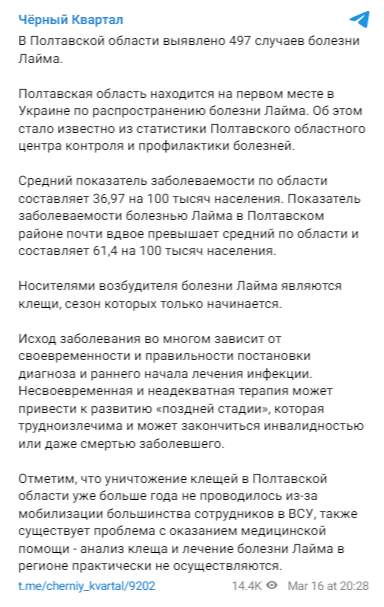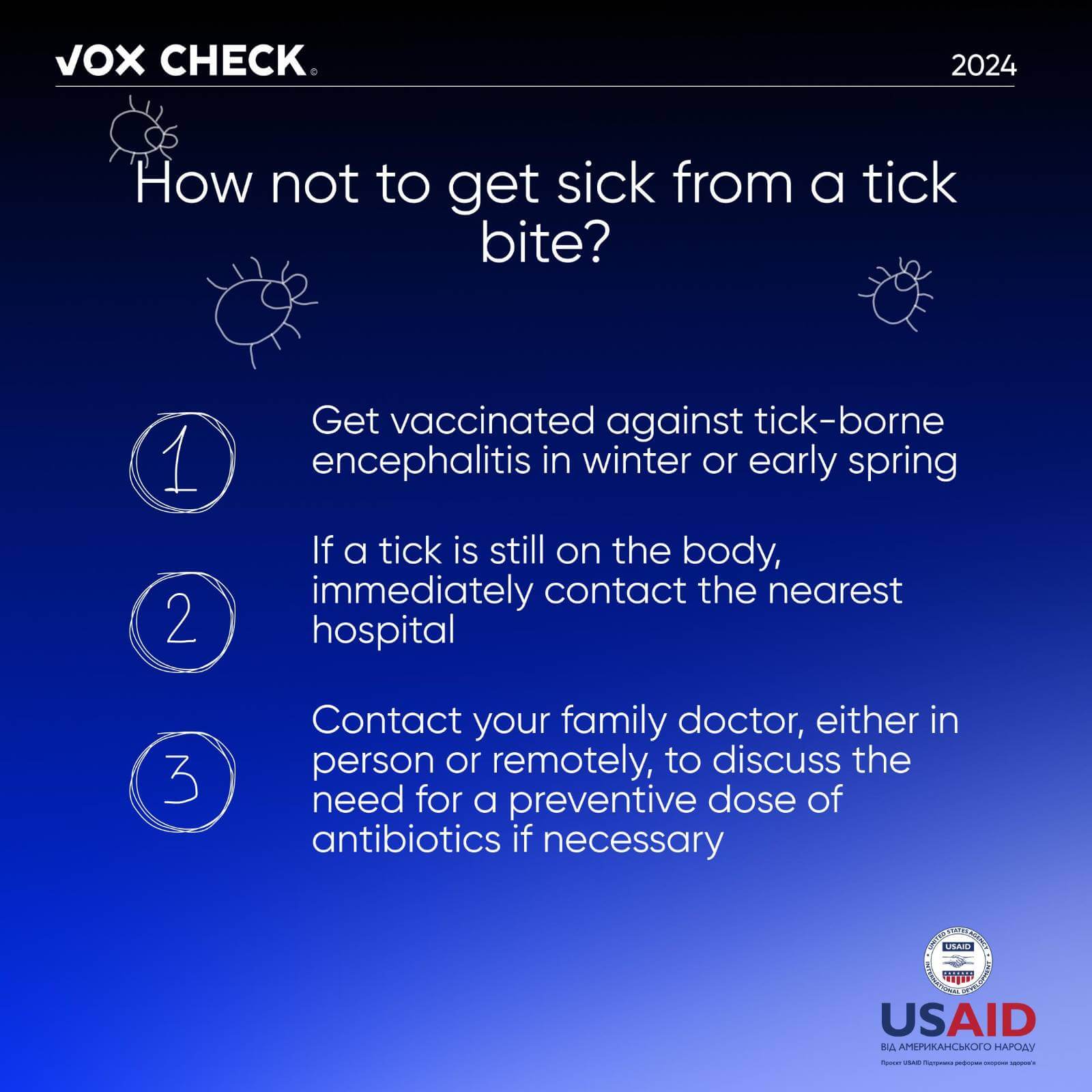This time, false information about the quality of medical care in the Poltava region is being spread through the network. The number of Lyme disease cases transmitted by ticks is increasing in the region, which fake creators have taken advantage of. They invented that the reason is supposedly the mobilization of workers — which ones, they do not specify. They also used the fact of the increase in incidence to discredit the work of the medical system in Ukraine.
With the support of the USAID Health Reform Support project, VoxCheck analyzes and refutes public health narratives spread in the information space of Ukraine, Belarus, and russia on a weekly basis.
Information is being spread online that ticks are not being eradicated in the Poltava region because most workers have been mobilized to the Armed Forces of Ukraine. Additionally, there is a problem with providing medical care — testing ticks and treating Lyme disease (borreliosis) in the region are practically not being carried out.
Screenshot of the post
What’s the reality?
In the Poltava region, there is indeed an increase in cases of Lyme disease — one of the infectious diseases transmitted by ticks. In 2023, nearly 5,000 cases of Lyme disease were recorded in Ukraine — about 12 cases per 100,000 population. The incidence in the Poltava region (36.97 per 100,000 population) is the highest in Ukraine. In 2023, 497 cases of Lyme disease were registered in the region, while in 2022 there were 367 cases, which is 26 cases per 100,000 population. Overall, there is a trend of increasing the number of reported cases across Ukraine. In 2022, there were 3,875 cases registered in the country (9.3 cases per 100,000 population).
In addition, in the Poltava region, areas with natural foci of diseases transmitted by ticks have been identified. Insects that transmit the causative agent of Lyme disease have been found in every district of the region. Tick-borne viral encephalitis occurs less frequently. The areas at risk for the transmission of this disease are Myrhorod and Poltava districts, as well as the city of Poltava. Ticks in the Poltava and Lokhvytsia districts are carriers of the causative agent of Crimean-Congo hemorrhagic fever caused by the Congo virus.
Ticks can transmit many diseases, but not all insects are carriers of disease agents. In Ukraine, the most common are tick-borne viral encephalitis and Lyme disease.
Encephalitis is inflammation of the brain, which can result in paralysis and death of the patient. The encephalitis virus is most commonly transmitted to humans through tick bites, less commonly through the consumption of raw goat and cow milk, which can also be carriers of the virus. The best protection against tick-borne encephalitis is timely vaccination, especially for those who frequently spend time in nature such as doctors, military personnel, tourists, fishermen, and others.
Borrelia are bacteria that enter the human body during a tick bite and can cause Lyme disease. The first symptom of the disease may be redness at the site of the bite, headache, body aches, and fatigue. However, some cases may be asymptomatic and without visible signs. Therefore, it is important to consult a doctor and undergo a preventive course of antibiotics. There is no vaccine available for Lyme disease in humans.
Source: Ministry of Health of Ukraine
There is no basis to claim that the increase in illness is caused by the mobilization of workers. Overall, it is unknown which specific workers are being referred to. For example, the maintenance of parks and squares is not mandatory; such decisions are made by local authorities. For instance, in Lviv, this task is handled by the Municipal Enterprise “Preventive Disinfection” under an agreement with the Ecology Department of the Lviv City Council, while in Kremenchuk, it is managed by the Municipal Enterprise “Improvement of Kremenchuk.” Typically, subcontracted organizations are hired to carry out these tasks.
The claim that the analysis and treatment of Lyme disease are practically not carried out in the region is untrue. In May 2023, an average of five people per day turned to the trauma unit of the emergency medical care department of the first hospital in Poltava with complaints of tick bites, says Volodymyr Roshko, the acting head of the emergency medical care department of the first hospital in Poltava. “Usually, these are bites that require the removal of a foreign body, the tick. Sometimes this happens when people have already tried to remove these ticks themselves. And, as a rule, this is unsuccessful or unskillful. And they turn when there are already some complications from tick bites — swelling, inflammation. It is advisable not to engage in self-removal. After all, very often it ends with the fact that they remove some particle, but a particle remains, and then troubles begin,” warns the doctor.
After receiving initial treatment, patients need to undergo a preventive course of antibiotics to prevent complications and the transition of the disease into a chronic form. The prescription for their receipt is issued by the family doctor, and the medicines themselves can be found in pharmacies. Laboratories also offer to take a test for antibodies to Lyme disease. It is necessary to assess the dynamics of treatment and is usually performed several weeks after the tick bite. Therefore, assistance and treatment for tick bites are available to residents of Poltava and other cities in Ukraine.
This information piece was produced with the assistance of the United States Agency for International Development (USAID), provided on behalf of the people of the United States of America. This article’s content, which does not necessarily reflect the views of USAID, the United States Government, is the sole responsibility of Deloitte Consulting under contract #72012118C00001.
Attention
The author doesn`t work for, consult to, own shares in or receive funding from any company or organization that would benefit from this article, and have no relevant affiliations




